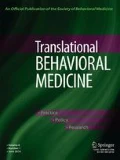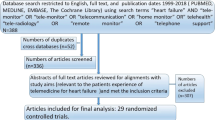Abstract
Care transitions from the hospital to home remain a vulnerable time for many patients, especially for those with heart failure (CHF) and chronic obstructive pulmonary disease (COPD). Despite regular use in chronic disease management, it remains unclear how technology can best support patients during their transition from the hospital. We sought to evaluate the impact of a technology-supported care transition support program on hospitalizations, days out of the community and mortality. Using a pragmatic randomized trial, we enrolled patients (511 enrolled, 478 analyzed) hospitalized with CHF/COPD to “E-Coach,” an intervention with condition-specific customization and in-hospital and post-discharge support by a care transition nurse (CTN), interactive voice response post-discharge calls, and CTN follow-up versus usual post-discharge care (UC). The primary outcome was 30-day rehospitalization. Secondary outcomes included (1) rehospitalization and death and (2) days in the hospital and out of the community. E-Coach and UC groups were similar at baseline except for gender imbalance (p = 0.02). After adjustment for gender, our primary outcome, 30-day rehospitalization rates did not differ between the E-Coach and UC groups (15.0 vs. 16.3 %, adjusted hazard ratio [95 % confidence interval]: 0.94 [0.60, 1.49]). However, in the COPD subgroup, E-Coach was associated with significantly fewer days in the hospital (0.5 vs. 1.6, p = 0.03). E-Coach, an IVR-augmented care transition intervention did not reduce rehospitalization. The positive impact on our secondary outcome (days in hospital) among COPD patients, but not in CHF, may suggest that E-Coach may be more beneficial among patients with COPD.
NIH trial registry number: NCT01135381
Trial Protocol: http://dx.doi.org/10.1016/j.cct.2012.08.007


Similar content being viewed by others
References
Forster AJ, Murff HJ, Peterson JF, et al. The incidence and severity of adverse events affecting patients after discharge from the hospital. Ann Intern Med. 2003; 138(3): 161-7.
Tsilimingras D, Bates DW. Addressing postdischarge adverse events: a neglected area. Jt Comm J Qual Patient Saf. 2008; 34(2): 85-97.
Epstein K, Juarez E, Loya K, et al. Frequency of new or worsening symptoms in the posthospitalization period. J Hosp Med. 2007; 2(2): 58-68.
Coleman EA, Berenson RA. Lost in transition: challenges and opportunities for improving the quality of transitional care. Ann Intern Med. 2004; 141(7): 533-6.
Coleman EA, Parry C, Chalmers S, Min SJ. The care transitions intervention: results of a randomized controlled trial. Arch Intern Med. 2006; 166(17): 1822-8.
Jack B, Bickmore T. The Re-Engineered Hospital Discharge Program to Decrease Rehospitalization. Care Management, 2011:p. 12-15.
Ggreenwald JL, Denham CR, Jack BW. The hospital discharge: a review of a high risk care transition with highlights of a reengineered discharge process. J Patient Saf. 2007; 3(2): 97-106.
Strunin L, Stone M, Jack B. Understanding rehospitalization risk: can hospital discharge be modified to reduce recurrent hospitalization? J Hosp Med. 2007; 2(5): 297-304.
Naylor MD. Nursing intervention research and quality of care: influencing the future of healthcare. Nurs Res. 2003; 52(6): 380-5.
Rau J, Medicare To Penalize 2,217 Hospitals For Excess Readmissions. http://www.kaiserhealthnews.org/stories/2012/august/13/medicare-hospitals-readmissions-penalties.aspx, Accessed 2/10/2013.
Mollon B, Holbrook AM, Keshavjee K, et al. Automated telephone reminder messages can assist electronic diabetes care. J Telemed Telecare. 2008; 14(1): 32-6.
Chumbler NR, Mann WC, Wu S, et al. The association of home-telehealth use and care coordination with improvement of functional and cognitive functioning in frail elderly men. Telemed J e-Health. 2004; 10(2): 129-37.
Cassimatis M, Kavanagh DJ. Effects of type 2 diabetes behavioural telehealth interventions on glycaemic control and adherence: a systematic review. J Telemed Telecare. 2012; 18(8): 447-50.
Corkrey R, Parkinson L. Interactive voice response: review of studies 1989–2000. Behav Res Methods Instrum Comput. 2002; 34(3): 342-353.
Crawford AG, Sikirica V, Goldfarb N, et al. Interactive voice response reminder effects on preventive service utilization. Am J Med Qual. 2005; 20(6): 329-36.
Bender BG, Apter A, Bogen DK, et al. Test of an interactive voice response intervention to improve adherence to controller medications in adults with asthma. J Am Board Fam Med. 2010; 23(2): 159-65.
Magid DJ, Ho PM, Olson KL, et al. A multimodal blood pressure control intervention in 3 healthcare systems. Am J Manag Care. 2011; 17(4): e96-103.
Xu C, Jackson M, Scuffham PA, et al. A randomized controlled trial of an interactive voice response telephone system and specialist nurse support for childhood asthma management. J Asthma. 2010; 47(7): 768-73.
Graham J, Tomcavage J, Salek D, et al. Postdischarge monitoring using interactive voice response system reduces 30-day readmission rates in a case-managed Medicare population. Med Care. 2012; 50(1): 50-7.
Academic E.D.S.R.C. The impact of screening, brief intervention and referral for treatment in emergency department patients’ alcohol use: a 3-, 6- and 12-month follow-up. Alcohol Alcohol. 2010; 45(6): 514-9.
Chaudhry SI, Mattera JA, Curtis JP, et al. Telemonitoring in patients with heart failure. N Engl J Med. 2010; 363(24): 2301-9.
Ritchie C, Richman J, Sobko H, et al. The E-coach transition support computer telephony implementation study: protocol of a randomized trial. Contemp Clin Trials. 2012; 33(6): 1172-9.
Sullivan MD, Levy WC, Russo JE, et al. Summary health status measures in advanced heart failure: relationship to clinical variables and outcome. J Card Fail. 2007; 13(7): 560-568.
Thorpe KE, Zwarenstein M, Oxman AD, et al. A pragmatic-explanatory continuum indicator summary (PRECIS): a tool to help trial designers. CMAJ. 2009; 180(10): E47-57.
Katzman R, Brown T, Fuld P, et al. Validation of a short Orientation-Memory-Concentration Test of cognitive impairment. Am J Psychiatry. 1983; 140(6): 734-9.
Linden A, Butterworth SW, Prochaska JO. Motivational interviewing-based health coaching as a chronic care intervention. J Eval Clin Pract. 2010; 16(1): 166-74.
Coleman EA, Mahoney E, Parry C. Assessing the quality of preparation for posthospital care from the patient’s perspective: the care transitions measure. Med Care. 2005; 43(3): 246-55.
Coleman EA, Smith JD, Frank JC, et al. Preparing patients and caregivers to participate in care delivered across settings: the Care Transitions Intervention. J Am Geriatr Soc. 2004; 52(11): 1817-25.
Wallace LS, Rogers ES, Roskos SE, et al. Brief report: screening items to identify patients with limited health literacy skills. J Gen Intern Med. 2006; 21(8): 874-7.
Salvi F, Miller MD, Grilli A, et al. A manual of guidelines to score the modified cumulative illness rating scale and its validation in acute hospitalized elderly patients. J Am Geriatr Soc. 2008; 56(10): 1926-31.
Takahashi PY, Pecina JL, Upatising B, et al. A randomized controlled trial of telemonitoring in older adults with multiple health issues to prevent hospitalizations and emergency department visits. Arch Intern Med. 2012; 172(10): 773-9.
Vinson JM, Rich MW, Sperry JC, et al. Early readmission of elderly patients with congestive heart failure. J Am Geriatr Soc. 1990; 38(12): 1290-5.
Harrison MB, Browne GB, Roberts J, et al. Quality of life of individuals with heart failure: a randomized trial of the effectiveness of two models of hospital-to-home transition. Med Care. 2002; 40(4): 271-82.
Pinnock H, Hanley J, McCloughan L, et al. Effectiveness of telemonitoring integrated into existing clinical services on hospital admission for exacerbation of chronic obstructive pulmonary disease: researcher blind, multicentre, randomised controlled trial. BMJ. 2013; 347: f6070.
Flodgren G, Rachas A, Farmer AJ, et al. Interactive telemedicine: effects on professional practice and health care outcomes. Cochrane Database Syst Rev. 2015; 9, CD002098.
Piette JD, Striplin D, Marinec N, et al. A Mobile Health Intervention Supporting Heart Failure Patients and Their Informal Caregivers: A Randomized Comparative Effectiveness Trial. J Med Internet Res. 2015; 17(6), e142.
Sherrard H, Duchesne L, Wells G, et al. Using interactive voice response to improve disease management and compliance with acute coronary syndrome best practice guidelines: A randomized controlled trial. Can J Cardiovasc Nurs. 2015; 25:(1).
Thomson M, Volk M, Kim HM, Piette JD. An Automated Telephone Monitoring System to Identify Patients with Cirrhosis at Risk of Re-hospitalization. Dig Dis Sci. 2015; 60(12): 3563-9.
Foust JB, Naylor MD, Boling PA, Cappuzzo KA. Opportunities for improving post-hospital home medication management among older adults. Home Health Care Serv Q. 2005; 24(1-2): 101-22.
Moore C, Wisnivesky J, Williams S, McGinn T. Medical errors related to discontinuity of care from an inpatient to an outpatient setting. J Gen Intern Med. 2003; 18(8): 646-51.
Willig JH, Krawitz M, Panjamapirom A, et al. Closing the Feedback Loop: An Interactive Voice Response System to Provide Follow-up and Feedback in Primary Care Settings. J Med Syst. 2013; 37(2): 9905.
Haas JS, Iyer A, Orav EJ, et al. Participation in an ambulatory e-pharmacovigilance system. Pharmacoepidemiol Drug Saf. 2010; 19(9): 961-9.
Acknowledgments
Contributors
Special thanks to Mr. Will Callans who played a key role in recruitment, retention, and assurance of data quality of this study and to Dr. Deborah Barnes for editing and preparing the revised manuscript for submission.
Prior presentations
E-Coaching: Interactive Voice Response (IVR)-Enhanced Care Transition Support for Complex Patients. AHRQ National Webinar: Leveraging Health Information Technology for Patient Empowerment. AHRQ National Resource Center for Health Information Technology April 8, 2010; Care Coordination and Care Transitions through Workflow Management. AHRQ Health IT Grantee and Contractor Meeting; Washington, DC; June 2–5, 2010.
Author information
Authors and Affiliations
Corresponding author
Ethics declarations
Research involving human participants
Ethical approval for the study was granted by the University of Alabama at Birmingham Institutional Review Board. All subjects (or their proxies) provided written informed consent for study participation.
Conflict of interest
The authors declare that they have no conflict of interests.
Funding
This study was in part supported by the Agency for Healthcare Research and Quality of Care of Complex Patients grant (R18-HS017786-02).
Additional information
Implication
Policymakers: The benefit of post-discharge support in COPD patients suggests different needs from those with heart failure and supports the need for personalized post-discharge care approaches as part of population health policies.
Researchers: Research is still needed to better understand which components of the IVR may be influencing hospital readmission rates so that systems can be further refined for optimal outcomes.
Practitioners: To optimize care after discharge, a tiered approach may be required with patient activation/coaching for those with moderate needs (COPD) and active medical support and guidance added to coaching for particularly complex patients (CHF).
About this article
Cite this article
Ritchie, C.S., Houston, T.K., Richman, J.S. et al. The E-Coach technology-assisted care transition system: a pragmatic randomized trial. Behav. Med. Pract. Policy Res. 6, 428–437 (2016). https://doi.org/10.1007/s13142-016-0422-8
Published:
Issue Date:
DOI: https://doi.org/10.1007/s13142-016-0422-8




